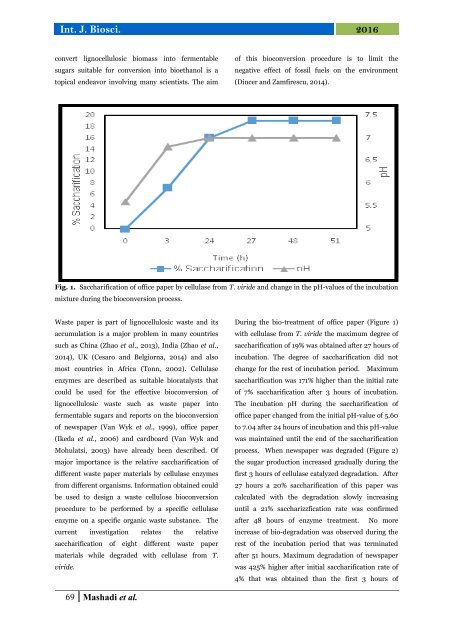Cellulas catalyzed bio conversion of different waste paper materials into ferment able sugars | By P. Mokatse
Cellulose catalyzed bio-conversion of different waste paper materials into ferment able sugars
Cellulose catalyzed bio-conversion of different waste paper materials into ferment able sugars
You also want an ePaper? Increase the reach of your titles
YUMPU automatically turns print PDFs into web optimized ePapers that Google loves.
Int. J. Biosci. 2016<br />
convert lignocellulosic <strong>bio</strong>mass <strong>into</strong> <strong>ferment</strong><strong>able</strong><br />
<strong>sugars</strong> suit<strong>able</strong> for <strong>conversion</strong> <strong>into</strong> <strong>bio</strong>ethanol is a<br />
topical endeavor involving many scientists. The aim<br />
<strong>of</strong> this <strong>bio</strong><strong>conversion</strong> procedure is to limit the<br />
negative effect <strong>of</strong> fossil fuels on the environment<br />
(Dincer and Zamfirescu, 2014).<br />
Fig. 1. Saccharification <strong>of</strong> <strong>of</strong>fice <strong>paper</strong> by cellulase from T. viride and change in the pH-values <strong>of</strong> the incubation<br />
mixture during the <strong>bio</strong><strong>conversion</strong> process.<br />
Waste <strong>paper</strong> is part <strong>of</strong> lignocellulosic <strong>waste</strong> and its<br />
accumulation is a major problem in many countries<br />
such as China (Zhao et al., 2013), India (Zhao et al.,<br />
2014), UK (Cesaro and Belgiorna, 2014) and also<br />
most countries in Africa (Tonn, 2002). <strong>Cellulas</strong>e<br />
enzymes are described as suit<strong>able</strong> <strong>bio</strong>catalysts that<br />
could be used for the effective <strong>bio</strong><strong>conversion</strong> <strong>of</strong><br />
lignocellulosic <strong>waste</strong> such as <strong>waste</strong> <strong>paper</strong> <strong>into</strong><br />
<strong>ferment</strong><strong>able</strong> <strong>sugars</strong> and reports on the <strong>bio</strong><strong>conversion</strong><br />
<strong>of</strong> news<strong>paper</strong> (Van Wyk et al., 1999), <strong>of</strong>fice <strong>paper</strong><br />
(Ikeda et al., 2006) and cardboard (Van Wyk and<br />
Mohulatsi, 2003) have already been described. Of<br />
major importance is the relative saccharification <strong>of</strong><br />
<strong>different</strong> <strong>waste</strong> <strong>paper</strong> <strong>materials</strong> by cellulase enzymes<br />
from <strong>different</strong> organisms. Information obtained could<br />
be used to design a <strong>waste</strong> cellulose <strong>bio</strong><strong>conversion</strong><br />
procedure to be performed by a specific cellulase<br />
enzyme on a specific organic <strong>waste</strong> substance. The<br />
current investigation relates the relative<br />
saccharification <strong>of</strong> eight <strong>different</strong> <strong>waste</strong> <strong>paper</strong><br />
<strong>materials</strong> while degraded with cellulase from T.<br />
viride.<br />
During the <strong>bio</strong>-treatment <strong>of</strong> <strong>of</strong>fice <strong>paper</strong> (Figure 1)<br />
with cellulase from T. viride the maximum degree <strong>of</strong><br />
saccharification <strong>of</strong> 19% was obtained after 27 hours <strong>of</strong><br />
incubation. The degree <strong>of</strong> saccharification did not<br />
change for the rest <strong>of</strong> incubation period. Maximum<br />
saccharification was 171% higher than the initial rate<br />
<strong>of</strong> 7% saccharification after 3 hours <strong>of</strong> incubation.<br />
The incubation pH during the saccharification <strong>of</strong><br />
<strong>of</strong>fice <strong>paper</strong> changed from the initial pH-value <strong>of</strong> 5.60<br />
to 7.04 after 24 hours <strong>of</strong> incubation and this pH-value<br />
was maintained until the end <strong>of</strong> the saccharification<br />
process. When news<strong>paper</strong> was degraded (Figure 2)<br />
the sugar production increased gradually during the<br />
first 3 hours <strong>of</strong> cellulase <strong>catalyzed</strong> degradation. After<br />
27 hours a 20% saccharification <strong>of</strong> this <strong>paper</strong> was<br />
calculated with the degradation slowly increasing<br />
until a 21% saccharizzfication rate was confirmed<br />
after 48 hours <strong>of</strong> enzyme treatment. No more<br />
increase <strong>of</strong> <strong>bio</strong>-degradation was observed during the<br />
rest <strong>of</strong> the incubation period that was terminated<br />
after 51 hours. Maximum degradation <strong>of</strong> news<strong>paper</strong><br />
was 425% higher after initial saccharification rate <strong>of</strong><br />
4% that was obtained than the first 3 hours <strong>of</strong><br />
69 Mashadi et al.


















